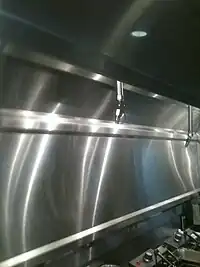Fire suppression systems are used to extinguish, control, or in some cases, entirely prevent fires from spreading or occurring. Fire suppression systems have an incredibly large variety of applications, and as such, there are many different types of suppression systems for different applications being used today. Of these, there are some that are still in use but are no longer legal to manufacture and produce.[1]
Suppression systems
Fire suppression systems are governed by the codes under the National Fire Protection Association, also known as the NFPA. This organization writes codes, regulations, and recommendations on the proper installation and maintenance of these fire suppression systems. Likewise, the NFPA also lists criteria that must be met for the requirements of certain types of fire suppression systems.[2]
Types
- Fire sprinkler systems
- Wet pipe
- Wet pipe antifreeze
- Dry pipe
- Pre-action
- Deluge
- Electronic
- Foam water sprinkler
- Water spray
- Water mist
- Gaseous agents
- Heat-absorbing gases
- Inert gases which displace oxygen
- Gases which disrupt the chain reaction of combustion
- Chemical agent systems
- Wet chemical
- Dry chemical
- Fully automatic suppression systems
- Fully automatic vehicle fire suppression systems
- Manual vehicle fire suppression systems
- External water spray system

Fire sprinkler systems
A fire sprinkler system is an active fire protection method, consisting of a water supply system, providing adequate pressure and flowrate to a water distribution piping system, onto which fire sprinklers are connected. Although historically only used in factories and large commercial buildings, systems for homes and small buildings are now available at a cost-effective price.[3] Fire sprinkler systems are extensively used worldwide, with over 40 million sprinkler heads fitted each year. In buildings completely protected by fire sprinkler systems, over 96% of fires were controlled by fire sprinklers alone.[4]
See also
References
- ↑ "H3R Aviation | FAQ - Aircraft fire extinguishers". H3R Aviation. Retrieved 2020-11-19.
- ↑ "NFPA". www.nfpa.org. Retrieved 2020-11-19.
- ↑ "Industrial Fire sprinklers : Firesafe.org.uk". www.firesafe.org.uk. Retrieved 2020-11-19.
- ↑ "NFPA report - U.S. Experience with Sprinklers". www.nfpa.org. Retrieved 2020-11-19.
